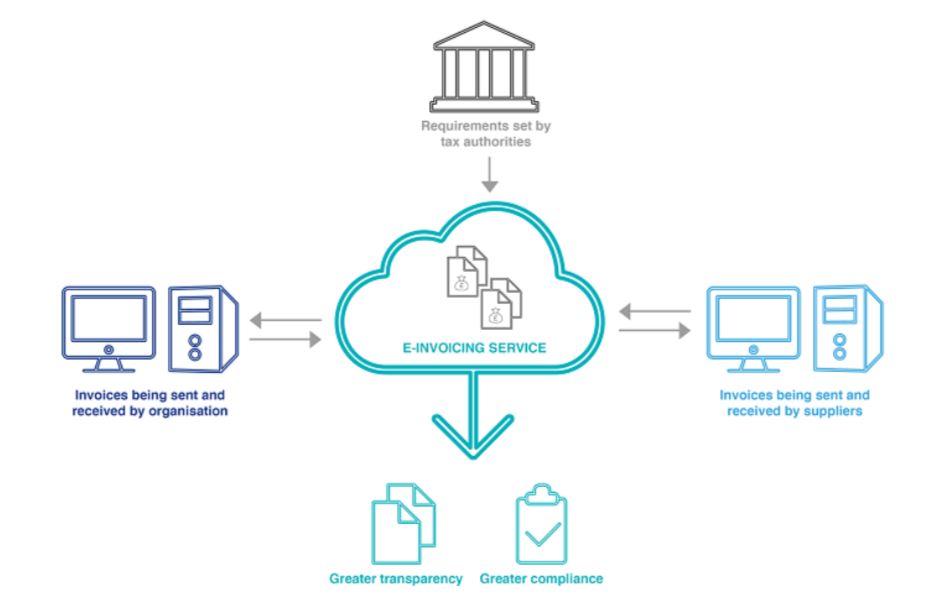Everyone agrees that businesses must adopt new digital practices and technologies to thrive in the digital age. However, for many businesses, implementing these new practices and technologies is easier said than done.
What is E-invoicing?
E-invoicing is a prime example of something that appears simple on paper but is difficult to implement in practice. E-invoicing is simply an electronic version of the paper invoice that businesses send to their suppliers when they purchase goods or services. It is intended to make the process faster, more transparent, and less expensive for all parties involved.
This digital trend is beneficial not only to users but also to governments and tax collection. One example of government use is the increased use of e-invoicing and electronic filing by government authorities – using digital tools to facilitate compliance and track fraud in a more timely and efficient manner.
Does it give you the impression that Big Brother is watching you? Inspired by artists like the Police in their song, “Every breath you take”:
Every breath you take
Every move you make
Every bond you break
Every step you take
I’ll be watching you
How does E-Invoicing Work?
To generate e-invoices, you’ll need an electronic device or a software solution that allows for real-time data delivery to the tax administration system for each e-invoice generated. To ensure compliance, you must also be well-prepared, as the new law on “fiscalization” has introduced a slew of new rules.
When you send an e-invoice, the buyer electronically accepts and signs the invoice. This will initiate a payment process that both you and the buyer can monitor. Depending on your company’s needs, you can either send the signed document to your customer as a PDF file or initiate an automated process that immediately updates your company’s accounts receivable system. Some e-invoicing services allow you to send an invoice before the work is completed. If you’re selling a service and need to set up a payment schedule with your client, this can be useful.
Different web-service endpoints are supported by electronic invoicing. You can use configurable integration with web services or several parametrized country-specific web service integrations. Different endpoints can be configured for the same web services and APIs by using different configuration versions.

While e-invoicing will help to streamline your business, it will not replace tax documents. Depending on where you live, you may be required to send your customers an invoice that includes all applicable tax information. The process differs for digital invoice providers. Some providers will automatically include the required tax information on your invoice, while others will require you to enter the information manually.
Check with your local taxing authority to see if you are required to collect taxes from your customers or send them tax documents. Currently, more than 60 countries have mandated or are considering mandating e-invoicing. Your turn will come up next. Will you be prepared?
How to Implement E-Invoicing
As more governments adopt mandatory e-invoicing, more businesses are facing a narrower window in which to provide a tax-compliant invoice.
You should begin by assessing your current situation, as with any new technology implementation.
Begin by assessing the current state of your paper-based invoice processes. What is effective? What could be done better? Consider your users and their requirements. What do different stakeholders prefer? What is their preferred method of communication? These questions can help you choose your software and determine how it will fit into your existing workflows.
ERP and E-Invoicing
E-invoicing requires the use of software that can connect to your Tax Authority’s system.
Governments and jurisdictions request a wide range of information, including trading partners, product descriptions, unit and discount prices, and payment terms. To make matters more complicated, this dizzying array of data is typically pulled from various departments.
You may be able to integrate your e-invoicing system with an ERP system like Microsoft Dynamics 365 Finance and Operations. This will give you access to a wealth of useful information and features. When your customer accepts and signs the invoice, your e-invoicing system may be able to generate an automatic purchase order.
Benefits of E-Invoicing
Microsoft Dynamics 365 Finance, Supply Chain Management, and Project Operations all have electronic invoicing capabilities. The functionality also makes it easier to comply with the most recent electronic invoicing standards and provides consistent experiences in electronic invoice processing and exchange across geographies.
The capabilities of electronic invoicing enable a variety of advantages, including:
- Easier and faster adaptation to country/regional requirements
- Standardization of the implementation of e-invoicing solutions
- Improved traceability of e-invoice processing
- Easier upkeep to meet changing legal requirements and local business practices
- Streamlined solution packaging
- The ability to scale a large volume of submitted documents results in a faster turnaround
- The ability to share your solutions with other businesses
Key Takeaway
Some of the push toward e-invoicing stems from the steady incremental shift toward cashless societies, as well as the accompanying technological disruptions. However, the larger, primary driver of e-invoicing adoption is the global wave of VAT and GST tax reforms, as well as ongoing efforts to combat tax evasion.
The key is to find the solution that works best for you and your specific situation.
Austria, Belgium, Brazil, Denmark, Egypt, Estonia, Finland, France, Germany, Italy, Netherlands, Norway, Spain, and Saudi Arabia have already developed integrations and enhancements for Microsoft Dynamics 365 Finance and Operations. With more countries on the horizon.
If your country/electronic region’s invoicing format isn’t listed, the Microsoft D365 Finance and Operations platform plans to support it in the future. You can still take advantage of electronic invoicing’s configuration capabilities and configure the electronic invoicing format yourself, or you can work with a partner/ISV to configure those for your organization.


